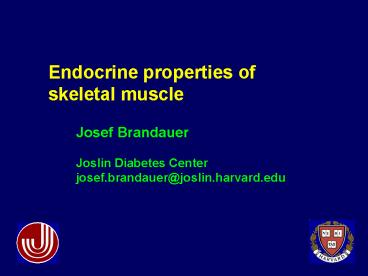Endocrine properties of skeletal muscle - PowerPoint PPT Presentation
1 / 32
Title:
Endocrine properties of skeletal muscle
Description:
Endo-/para-/juxta-/autocrine signaling. Classic' and novel' hormone ... acute rodent treadmill exercise, or in vitro contraction, function as a model? 16 ... – PowerPoint PPT presentation
Number of Views:118
Avg rating:3.0/5.0
Title: Endocrine properties of skeletal muscle
1
Endocrine properties of skeletal muscle
Josef Brandauer Joslin Diabetes
Center josef.brandauer_at_joslin.harvard.edu
2
Lecture overview
- Endo-/para-/juxta-/autocrine signaling
- Classic and novel hormone-secreting organs
- Protein secretion from skeletal muscle
- Interleukin-6 (IL-6)
- Retinol-binding protein 4 (RBP4) a novel
myokine?
3
Endocrine signaling
Endocrine vs. exocrine Endocrine ductless,
vascular, intracellular vacuoles/granules storing
hormones Exocrine ducts or hollow lumen much
less vascularized (salivary gland, sweat glands)
4
Other -crine signaling
Paracrine Target cell is close to
signal-releasing cell E.g. Allergic response,
scar formation, blot clotting, etc. Juxtacrine
requires physical contact between two
cells.E.g. Notch signalling Autocrine
secreting cell target cell E.g. Monocytes
(IL-1)
5
Hormones
Hormao Gr., to set in motion First use of
hormone Description of secretin, Bayliss and
Starling, 1902
6
Classic endocrine glands
Hypothalamus Thyrotropin-releasing hormone ?ACTH
(pituitary) Pituitary TSH, GH Thyroid
Triiodothyronine BMR, catecholamine sensitivity,
protein synthesis Adrenal medulla
Norepinephrine, epinephrine Pancreas insulin,
glucagon Liver IGF-1
7
Novel endocrine glands
Heart ANP, BNP blood pressure
regulation Adipose tissue leptin, adiponectin,
etc. satiety, insulin sensitivity,
etc. Skeletal muscle Interleukin-6, others?
8
Protein secretion from skeletal muscle
What purpose could this serve? -- Communicate a
change in skeletal muscle environment to other
tissue(s) -- Which change(s)? -- Which
tissue(s)?
9
Interleukin-6 (IL-6)
10
Interleukin-6 (IL-6)
11
Interleukin-6 (IL-6)
12
IL-6 before after hindlimb contraction
13
Retinol-binding protein 4 (RBP4)
Adipose-tissue G4KO animals are IR in vivo in
vitro glucose transport is not affected
14
(s)RBP4
- RBP4 occurs in serum as a tetramer with retinol
and transthyretin, the carrier protein for
thyroxine - AT mRNA and serum protein levels are increased in
adipo-G4KO mice - sRBP4 is elevated in other obesity/diabetes
models (ob/ob, HFD, etc.) - responsive to TZD treatment (AT mRNA, serum)
- RBP4-/- animals are more insulin sensitive than
WT control. - RBP4 injection impairs IRS-1 associated PI3k
activity in skeletal muscle
15
Connection between exercise and sRBP4
- Vitamin A (retinol) levels increase acutely with
endurance exercise known since the 1950s. - ? does this imply that sRBP4 is also increased?
- ?can acute rodent treadmill exercise, or in vitro
contraction, function as a model?
16
Acute exercise increases RBP4 in SD rats
AU, arbitrary units Sed, sedentary, Exer.,
exercise 60 post, 60 min after exercise. (N
indicated in bars).
17
Where does the exercise-induced increase in sRBP4
originate?
- Liver
- Adipose tissue
- Other tissues?
18
Acute exercise does not transiently induce RBP4
mRNA in liver
19
or visceral fat
20
but
acute exercise transiently increases RBP4 mRNA
in gastrocnemius muscle
Additionally, muscle-specific hRBP4 transgenic
animals show an interesting sRBP4 pattern
21
Soooo..
- is RBP4 a myokine?
22
- What does an individual muscle fiber show?
23
Retinol-binding protein 4 (RBP4)
24
Conclusion I
- Acute exercise-induced increases in sRBP4
concentration are likely a result of increased
skeletal muscle gene expression and RBP4
secretion - Liver and adipose tissue, 2 major sources of
sRBP4, are likely not involved in this process - Evidence for a myokine role of RBP4
- ? If RBP4 is a myokine, what would be its
physiological role during exercise?
25
Conclusion I
- Acute exercise-induced increases in sRBP4
concentration are likely a result of increased
skeletal muscle gene expression and RBP4
secretion - Liver and adipose tissue, 2 major sources of
sRBP4, are likely not involved in this process - Evidence for a myokine role of RBP4
- ? If RBP4 is a myokine, what would be its
physiological role during exercise?
26
What are the effects of RBP4 on exercise capacity?
First, some background
fvb mice H4IIe H4IIe
- Levels of the gluconeogenic enzyme hepatic PEPCK
are regulated, either directly or indirectly, by
(circulating?) RBP4. - Implications on hepatic glucose production in
vivo? - functional connection to acute exercise?
27
Hypothesis
- Due to the involvement of RBP4 in regulating
hepatic glucose output, RBP4 deficient animals
have reduced exercise capacity, and elevated
post-exercise liver glycogen levels.
28
Descriptive data RBP4 KO/WT mice
29
Exercise graded exhaustive treadmill protocol
30
Sedentary and exercise lactate levels
Why?
Decreased gluconeogenesis?
31
Liver glycogen levels
32
Conclusion II
- RBP4 KO mice have reduced exercise capacity
compared to WT controls - Some evidence that BG levels during exercise will
decrease at an accelerated rate in KO animals - Despite no apparent difference in sedentary
glycogen, post-exercise glycogen levels are
approximately 3-fold greater in KO compared to WT
animals - Liver glycogen metabolism during acute exercise
may be impaired in RBP4 KO animals - Post-exercise blood lactate levels are increased
in RBP4 KO vs. WT animals ? impaired
gluconeogenesis?































